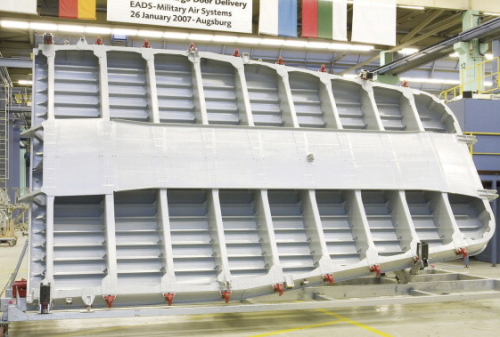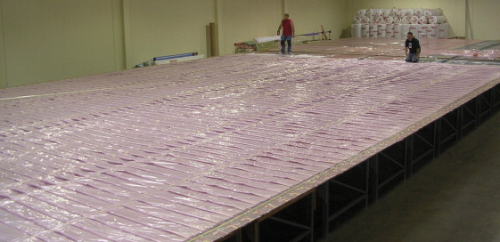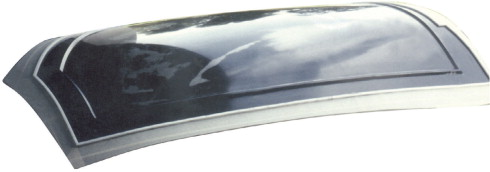


The latest developments such as the Airbus A350 or the Boeing 787 point to a trend in the comprehensive utilisation of composite structures in the aviation industry and a reduction in the use of titanium and steel to but a few structural elements. This is the outlook according to Franz Eckmann, managing director of Flugzeug-Union Süd GmbH (FUS) in Ottobrunn, Germany. The EADS Deutschland GmbH subsidiary will be one of the exhibitors at the Composites Europe exhibition (6-8 November 2007, Stuttgart, Germany), where the company will be informing visitors about its technologies.
The company, which has 64 employees, was founded in 1969 as the logistics and trading company of the former MBB (Messerschmitt Bölkow Blohm GmbH) with plants in Ottobrunn and Dachau. It provides a wide range of spare parts and auxiliary materials for the civil and military aviation industries, ranging from standard connection elements all the way up to complex aircraft equipment and industrial products. As well as the sale and marketing of adhesive substances and stripping compounds, and the patented FUS Dry Stripping System, the company's portfolio of business activities also includes industrial logistics/open depot filling (just-in-time supply of assembly lines), special packaging (that is to say the packaging and conservation of hazardous materials), air and sea freight and industrial commodities, the sale and marketing of spare parts for aircraft, as well as the provision of support services for light and older aircraft.
“We have been active in this area ever since Messerschmitt Bölkow Blohm started manufacturing composite structural elements – one of the first companies in Europe to do so – almost 30 years ago,” adds Eckmann.
In addition, FUS was recently named the official distributor for the entire range of Aerovac products in Germany and other European countries. Within the scope of these activities, FUS also distributes flexible, three-layered vacuum foil with a width of up to 12 m, reusable vacuum systems, as well as resin infusion products. The recent addition of the Aerovac portfolio broadens the existing spectrum with products manufactured by Richmond, which FUS has already been distributing in Germany and a number of other European countries for more than 20 years. According to Eckmann, “the combination of Aerovac and Richmond products represents the most complete range of vacuum process consumable materials that is available on the market.”
The conventional prepreg method is still preferred for the production of the majority of the components. In this method, the precut prepreg is inserted by hand. Subsequently, a tear-off material or separating foil is added to the final prepreg layer and a bleeder layer then follows. The vacuum foil is then draped over the whole thing, wrapped around it and sealed at the edges with sealing tape. The vacuum is created using autoclave pipes and the component is then cured in an oven under a pressure of up to 10 bar and at a temperature of up to 200°C.
FUS supplies practically all the renowned manufacturers in the aviation industry with materials such as vacuum foils, separating foils, tear-off materials, liquid stripping compounds, sealing tapes and bleeders. These are then used in the construction of horizontal and vertical tail planes, wings, landing flaps, radomes, pressure domes, interior furnishings, doors, rotor blades and root segments.
“The utilisation of composites in the aviation industry requires the corresponding qualification and certification,” explains Eckmann. “This is generally a lengthy and cost-intensive process that provides the customers with a guarantee of quality.”
Vacuum infusion
However, it is not only the long-standing tradition in the utilisation of composites in the aviation industry that originates from the south of Germany, but also the most modern and internationally most recognised technologies that originate there. For example, the innovative ‘Vacuum Assisted Process’ (VAP) manufacturing method. This patented infusion technology, for the infusion and curing of fibre reinforced plastic (FRP) components under vacuum, was developed by EADS Military Air Systems in Augsburg and results in a 20% reduction in production time in comparison with the current production method using prepregs. The method is also more cost efficient, consumes less energy and is consequently more environmentally friendly.
VAP uses membrane-supported low pressure infusion technology. With this method, the components that are to be infused are covered with gas and air micro-porous membranes that constitute a resin barrier. The size of the pores in the membranes is selected in a way that the gases and air can be transferred to a vacuum chamber outside the membrane. The resin that is introduced within the membrane is held back by it and remains in the so-called injection chamber.
The application of the VAP also means that the use of expensive autoclave ovens is no longer required, which results in considerable advantages, particularly in the case of the larger components.
This manufacturing process also increases flexibility in the manufacturing and preparation of components for serial production. On 26 January this year, the EADS plant in Augsburg supplied the first loading ramp for the new A400M military transport aircraft to Airbus in Bremen. The dimensions of about 7 m by 4 m make it the largest aircraft component in the world to be manufactured using VAP technology. The process is also used for the production of flap-track components for the new giant Airbus A380.
VAP technology has also made a name for itself beyond the aviation industry and is used by numerous companies worldwide. One application is the production of rotor blades for wind turbines.
Prepregs and profiles
The Krempel Group in Vaihingen supplies prepreg materials with thermoset and thermoplastic matrix systems, complex fibre-reinforced components, filament wound tubes, extruded plastic profiles and plastic sheets for the aviation and aerospace industries. The company has 750 employees, and is also exhibiting at
COMPOSITES EUROPE 2007 will be held on 6-8 November in Stuttgart, Germany, one of the world's most dynamic economic regions. In choosing this location the organisers Reed Exhibitions Deutschland GmbH, EuCIA and Reinforced Plastics continue their strategy of holding COMPOSITES EUROPE in the most important centres of composites application in Europe. After the successful first COMPOSITES EUROPE, a total of more than 200 exhibitors and 4000 international visitors are expected. Over 120 international companies, institutions and organisations have already booked a stand at COMPOSITES EUROPE 2007, including EADS, AOC, Huntsman, Menzolit, Exel Oyj, Röchling, and Büfa. |
Composites Europe 2007. Composites manufactured by the company have been being built into various Airbus types for more than 20 years.
For example, Krempel supplies the handles for the emergency exits of the Airbus A320, which are manufactured using Wacosit plastic profiles. Reinhard Kersten, the company's marketing director, says that “these extruded profiles stand out due to their good mechanical and thermal properties, high level of surface smoothness and reliable dimensional accuracy. If not only high tensile strength, but also enhanced compressive strength resistance and shear strength are required, then fibre ribbons and glass cloths are processed in addition to the rovings.”
The majority of the structural elements for the interior area are also manufactured using composites, including the wall panelling and the ventilation ducts.
“In this case we use phenolic resin prepregs on the basis of fibreglass materials,” explains Kersten. “These meet the high requirements that apply with regard to fire resistance, toxicity and smoke density.”
Krempel provides the System BD prepregs, which are based on modified epoxy resins with a high level of impact strength and excellent dynamic properties. These can be processed into high-tensile structural elements using all of the conventional methods. The curing range is around 85-140°C and the maximum thermal stability is at 125°C. The System BX prepreg possesses a wide curing range of about 55-185°C and therefore meets all the requirements for a low pressure/low temperature prepreg. It is suitable for the production of structural elements, as well as for composite tools with a thermal stability of up to 180°C. In this case again, all of the conventional processing methods are applicable.
Krempel also manufactures tubes (with round, elliptic, oval, rectangular or polygonal cross-section) using filament winding technology for particularly sophisticated and delicate applications. The fibres, resins, layer construction and the cross-section are selected depending on the application in order to manufacture components with customer-specific properties. Fibre combinations are often used for reasons of cost and stability. The winding angle is 0-90° and it is possible to achieve specific strength properties in the different load directions.
“In the meantime fibre composites have established themselves in aircraft construction,” explains Kersten. “By using different fibre matrix combinations it is possible to achieve tailored material properties. The high E-modulus and the high tensile strength at a low weight speak for themselves. Consequently, conventional materials are increasingly being replaced by prepregs.”
According to Kersten, epoxy prepregs are increasingly being used, particularly in the area of high-stress primary structures.
Great potential
Axson GmbH in Dietzenbach produces and supplies adhesive substances, laminating resins for tooling and self-extinguishing materials for interior areas to about 100 customers in the aviation industry. The German subsidiary of the French company will be exhibiting at Composites Europe.
“Due to their self-extinguishing properties, our materials are predestined for utilisation in the aviation industry”, explains sales and project manager Uwe Schåfer.
Epoxy laminating resins are used among others. Epoxy casting resins are used in the bonding and positioning of parts, drilling templates and deep drawing tools. Adhesives are used for the assembly of helicopter propeller blades, interior panelling and stunt aircraft structures.
Axson also provides surface resins for resin transfer moulding (RTM) and polyester forms, as well as deep-drawing tools. In addition, the company provides lightweight sheets for styling and design, high-volume models and gauge manufacturing. The range is complemented by honeycomb and wax sheets, prepregs and putty and filling pastes. Schåfer points out that the company has been active in the composites sector since 1938, almost 70 years.
“The company sees great potential for development in the future, particularly with regard to the aviation market segment,” he concludes.





